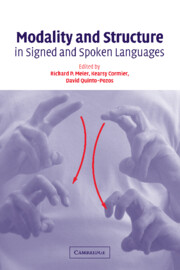Book contents
- Frontmatter
- Contents
- List of figures
- List of tables
- List of contributors
- Acknowledgements
- 1 Why different, why the same? Explaining effects and non-effects of modality upon linguistic structure in sign and speech
- Part I Phonological structure in signed languages
- Part II Gesture and iconicity in sign and speech
- Part III Syntax in sign: Few or no effects of modality
- Part IV Using space and describing space: Pronouns, classifiers, and verb agreement
- 13 Pronominal reference in signed and spoken language: Are grammatical categories modality-dependent?
- 14 Is verb agreement the same crossmodally?
- 15 The effects of modality on spatial language: How signers and speakers talk about space
- 16 The effects of modality on BSL development in an exceptional learner
- 17 Deictic points in the visual–gestural and tactile–gestural modalities
- Index
- References
16 - The effects of modality on BSL development in an exceptional learner
Published online by Cambridge University Press: 22 September 2009
- Frontmatter
- Contents
- List of figures
- List of tables
- List of contributors
- Acknowledgements
- 1 Why different, why the same? Explaining effects and non-effects of modality upon linguistic structure in sign and speech
- Part I Phonological structure in signed languages
- Part II Gesture and iconicity in sign and speech
- Part III Syntax in sign: Few or no effects of modality
- Part IV Using space and describing space: Pronouns, classifiers, and verb agreement
- 13 Pronominal reference in signed and spoken language: Are grammatical categories modality-dependent?
- 14 Is verb agreement the same crossmodally?
- 15 The effects of modality on spatial language: How signers and speakers talk about space
- 16 The effects of modality on BSL development in an exceptional learner
- 17 Deictic points in the visual–gestural and tactile–gestural modalities
- Index
- References
Summary
Introduction
This chapter reports on the findings of an experiment into the learning of British Sign Language (BSL) by Christopher, a linguistic savant, and a control group of talented second language learners. The results from tests of comprehension and production of morphology and syntax, together with observations of his conversational abilities and judgments of grammaticality, indicate that despite his dyspraxia and visuo-spatial impairments, Christopher approaches the task of learning BSL in a way largely comparable to that in which he has learned spoken languages. However, his learning of BSL is not uniformly successful. Although Christopher approaches BSL as linguistic input, rather than purely visuo-spatial information, he fails to learn completely those parts of BSL for which an intact nonlinguistic visuo-spatial domain is required (e.g. the BSL classifier system). The unevenness of his learning supports the view that only some parts of language are modality-free.
Accordingly, this case illuminates crossmodality issues, in particular, the relationship of sign language structures and visuo-spatial skills. By exploring features of Christopher's signing and comparing it to normal sign learners, new insights can be gained into linguistic structures on the one hand and the cognitive prerequisites for the processing of signed language on the other.
In earlier work (see Smith and Tsimpli 1995 and references therein; also Tsimpli and Smith 1995; 1998; Smith 1996; Smith and Tsimpli 1996; 1997; Morgan, Smith, Tsimpli, and Woll 2002), we have documented the unique language learning abilities of a polyglot savant, Christopher (date of birth: January, 6 1962).
- Type
- Chapter
- Information
- Modality and Structure in Signed and Spoken Languages , pp. 422 - 441Publisher: Cambridge University PressPrint publication year: 2002
References
- 2
- Cited by



